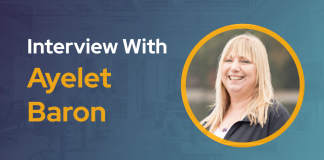Hi Teri, tell us about yourself and your background?
I have 20+ years of experience helping some of the world’s most recognizable brands transform their marketing and communications programs to enhance their reputation, market position, and sales trajectory.
In 2019, I founded /grōTH/ to help companies optimize their marketing and communications programs to increase sales. /grōTH/ serves as an objective resource for the C-suite and investors to ensure the right programs, people, and processes are in place to grow.
Prior to /grōTH/, I held leadership roles at global PR agencies and on the marketing teams of Samsung, Microsoft, HTC, and Huawei.
Full disclosure, I don’t consider myself a CX expert. I focus on helping companies unlocking each stakeholder in their ecosystem to remove barriers, create advocacy, and generate demand. The customer experience is an essential part of my process.
Online commerce was booming in 2020, and so did consumer reviews. – How can brands better utilize this data to improve their customers’ experience?
Customer reviews are a window into how well we are doing as a company with our products and our service. If companies aren’t leveraging that insight to improve and have a dialogue with customers, they limit their potential and ability to compete.
The bigger question is: are companies resourced adequately to leverage this insight?
There has been a slow but consistent rise in companies adding a marketing analytics position or team the past few years. Analytics has become a mandatory capability for two reasons: insight and automation.
The companies that are at the forefront of analytics will be the big winners because they can customize their approach based on the customer, their journey, and the touchpoints. On each end of the spectrum, you have advocates and detractors that each needs their own strategy, while in the middle, you have bystanders that could go either way based on how you respond to the other two.
As marketers, we are seeing quantum leaps in the number of marketing technologies available—most focusing on a specific area of marketing, automating our processes, and providing us with endless data. We need individuals who can put the right solutions together and translate the data into actionable insights.
In your POV – What is the ultimate checklist for a good customer experience strategy?
I believe it begins with the company’s mission and purpose. If a company doesn’t have a customer-centric mission, it will be challenging to create a great customer experience.
The next step is ensuring the entire organization subscribes to the customer-centric mission and that each department has its own CX vision statement, strategy, and metrics. The customer experience is the responsibility of every employee, not just the customer service or marketing teams.
The most essential tool is a well-defined customer experience playbook that aggregates the entire organization’s plan to create an amazing customer experience. The CX Playbook should include a CX vision statement, goal(s), strategy, and measurable objectives. It should clearly define who your customers are by including research, customer personas, and an empathy map. It should also map their journey, including specific touchpoints. This is also a good place to outline gaps and challenges and what you will do to address them.
I call it a playbook because it should be used and revised on an ongoing basis. It will evolve as you measure, gain new insights, and evolve.
How much has the role of customer experience changed in the social distancing era – what role digital transformation has in this crisis?
Having the ability to rely on in-person interactions cloaked online shortcomings. 2020 exposed brands in a way that we could not have imagined. The brands that were not committed to optimizing the virtual customer experience are suffering greatly and will continue to do so until they do.
For example, these are the companies that don’t offer live support or can cancel or change a service online. They don’t provide call-back service instead of making customers wait endlessly on hold. Companies need to visualize the consumer experience from buying to returns, and they need to experience it. If you make buying, returning, or getting support difficult by creating barriers and hurdles for customers, they will not forget and they will let everyone know, which will dissuade others from buying.
Don’t mortgage your future by focusing on short-term profit. Instead, focus on building lifelong customers.
What was the biggest lesson you learned in 2020?
I’ve spent my entire career helping companies change the way the world views them. Most often, this is done through a thought leadership program and branding pivots. Corporate citizenship has always been an essential part of this, but 2020 required companies to be empathetic. They had to shift from leveraging to helping their stakeholders and putting people before profits. It is a lesson that we should never forget. The companies that adapted very quickly and successfully will be rewarded for it.
I think Glinda the Good Witch had it right. “You’ve always had the power, my dear. You just had to learn it for yourself.”
2020 was the year of webinars and online events; what was your favorite one?
I have certainly participated in more webinars and online events in one year than the past five years collectively. I would have to say CES 2021 because I doubted that it would be the same, but I gained more from attending online. I was able to hear more speakers and see products than I would have been able to at the physical show because of the sheer volume and size of CES. Plus, I wasn’t exhausted, and my feet didn’t hurt at the end of each day.
It looks like working from home is going to stay with us for the foreseeable future. How should Executives gear up to the changing times?
I’ve always said, “work is a verb, not a noun,” and the past year has demonstrated that we don’t have to be physically together to get work done. I believe companies have an opportunity to rethink their long-term approach to staffing. They can now hire the best talent regardless of location, and they can design teams to cover the entire day/week to be even more productive without overworking their staff. Designing a team to be available to your customers regardless of what time or day it is will be a powerful advantage.
Communication is essential to working remotely, though. This includes ensuring leadership communicates priorities and purpose often to keep everyone aligned, and providing tools to ensure employees can communicate and collaborate with each other. Ensure the tools are shareable and enable real-time collaboration.
With regard to customers, companies need to take a hard look at the virtual customer experience. Is it easy to connect with the company if you have a question or a problem? Have you removed the barriers to buying or the self-serve process?
Last but not least, what is your favorite CX metric?
This is a great question, and I’d say that it depends. What is right for one company may not be right for another. There isn’t a single metric that can get the job done, but it can be overwhelming to measure everything. However, measurement is critical, so it is surprising when a company doesn’t use data to guide decision-making and improvement.
The best way to think about measurement so that it doesn’t seem so daunting is:
1) the customer journey as a whole,
2) each phase of the journey, and
3) specific touchpoint performance.
Marketers today benefit from the growth of marketing technologies that automate a lot of these processes. For the companies that can’t afford them, there are countless free templates. I would suggest focusing on your weak spots first and then improving where you are doing well. Can you do 10% better each month or quarter?
That said, I think an Empathy Map can be very insightful because it helps you understand the needs of customers and to predict what actions you should take based on their beliefs, emotions, and behaviors. Communicators plan and prepare extensively for a potential crisis. CX can learn a lot from that process, and an Empathy Map is one tool that helps you do that.






